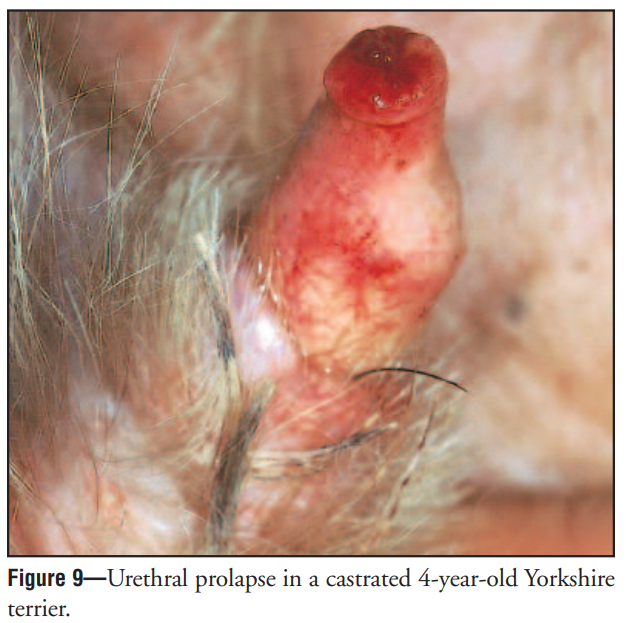32. Disorders of the penis and prepuce – balanoposthitis, priapism, urethral prolapse
1/30
There's no tags or description
Looks like no tags are added yet.
Name | Mastery | Learn | Test | Matching | Spaced |
|---|
No study sessions yet.
31 Terms
What is balanoposthitis?
Inflammation of the penis and prepuce
What are some potential consequences of balanoposthitis?
Stenosis of the preputial orifice, adhesions of the penis, pain
In which age group of dogs is balanoposthitis sometimes seen due to an immature immune system?
Young dogs close to puberty
What are some infectious causes of balanoposthitis?
Herpesvirus, calicivirus, ascending or descending bacterial infections
What are some non-infectious causes of balanoposthitis?
Trauma, licking/self-mutilation
What are the clinical signs of balanoposthitis?
Red mucous membranes, green or yellow discharge, painful urination (dripping)
How is balanoposthitis diagnosed?
Presence of discharge, bacterial swab, cytology
What are the treatment options for balanoposthitis?
E-collar, flushing the prepuce with warm saline/antiseptic, enlarging the preputial opening, antibiotics, sexual rest
What is priapism?
A persistent erection lasting more than 4 hours without sexual stimulation and not due to hormones
Is priapism more common in younger or older dogs?
Older dogs
What are some neurological disorders that can cause priapism?
(Not specified in the text)
What are some vascular causes of priapism?
Veno-occlusion due to thrombus, neoplasia, or trauma
What medications can cause priapism?
Phenothiazine tranquillisers, general anaesthesia
What other systemic disease is listed as a potential cause of priapism?
Diabetes
What are the two main types of priapism?
Non-ischaemic (arterial, high flow) and ischaemic (veno-occlusive, low flow)
What are the clinical signs of priapism?
Dysuria, stranguria, haematoma, necrosis
How is priapism diagnosed?
History (drug use), blood tests (metabolic disease, neoplasia, coagulation), urinalysis, X-ray, USG
What are some treatment options for priapism?
Flushing with heparinized saline, infusion with sympathomimetic drugs (phenylephrine), amputation and urethrostomy if severe
Is castration an effective treatment for priapism?
No, it is not hormonally mediated
How does the hormonal basis of priapism differ from paraphimosis?
Priapism is not hormonal, while paraphimosis is testosterone-mediated and related to sexual stimulation
What is urethral prolapse?
The inner lining of the urethra protruding through the urethral opening and becoming oedematous
What are some potential causes of urethral prolapse?
Urethritis, sexual arousal, or masturbation
In which age group and breed is urethral prolapse most common?
Dogs less than 5 months old, especially English bulldogs
What are the clinical signs of urethral prolapse?
Pea-sized red or purple mass at the end of the penis, difficulty urinating, licking, pollakiuria

How is urethral prolapse diagnosed?
Physical examination (intermittent blood drops from the penis tip, visible prolapse)
What are the treatment options for urethral prolapse?
E-collar, sexual rest, tranquillisers, resection of the prolapse or manual reduction with catheterisation and suturing of the urethra to the penis shaft if bleeding or pain is significant
What is pollakiuria?
Abnormally frequent urination.
What is stranguria?
Slow and painful urination.
What is dysuria?
Difficult or painful urination.
What is haematoma in the context of priapism?
A collection of blood within the tissues of the penis.
What is necrosis in the context of priapism?
Tissue death due to prolonged lack of blood flow.